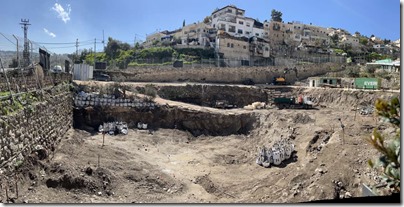There won’t be a roundup tomorrow, so today’s is a long one (with 30 items). I am grateful for tips this week from Agade, Keith Keyser, Arne Halbakken, Gordon Dickson, and Mark Hoffman. See the last item for a word about the future.
Archaeologists made some discoveries in preparing to open to the public the tomb of Salome, the traditional midwife of Jesus. The cave is situated along the route of the new Judean Kings Trail, which runs from Beersheba to Beit Guvrin.
“Israeli archaeologists have discovered the earliest evidence of cotton in the ancient Near East during excavations at Tel Tsaf, a 7,000-year-old town in the Jordan Valley.”
A group of schoolchildren discovered a Roman oil lamp while walking in Galilee.
“Israel is embarking on a challenge to make the mapping of archaeological sites tech-savvy using remote underground sensor technology in a move to cut costs and resources used up by extensive excavation.”
The NY Times looks at the hope for dating ancient remains offered by archaeomagnetism.
Some are seeking the Israeli government to turn the ruins of the Hasmonean and Herodian palaces at Jericho into a national park in order to preserve it and make it accessible to Israelis.
The Temple Mount Sifting Project has been making great progress, but they need financial support.
The Temple: Then and Now is a forthcoming five-episode video project from Bible Land Passages. They have just released a trailer.
Joseph Lauer has observed that most respectable news outlets have ignored the recent claims of Gershon Galil to have discovered five inscriptions in and around Hezekiah’s Tunnel. He links to one article (in Hebrew) which quotes Dr. Barkay as saying, “I haven’t seen anything yet that convinces me that this is true. We have to wait for a scientific publication and better photos that will clarify what is there.” Carl Rasmussen shares photos of the location of one of the alleged inscriptions.
ASOR webinar on Jan 12: “‘Earliest Inscription Found!’ Exposing Sensationalism in the Field of Ancient Inscriptions,” by Christopher Rollston ($12)
“20 ancient tombs dating back to as early as 660 BC were uncovered in the city of New Damietta in Egypt’s Nile delta.”
“An ancient Egyptian painting [in a palace at Amarna] is so detailed, researchers can determine which species of birds were featured in it.”
Conservators in Iraq’s national museum are working to preserve and digitize 47,000 ancient manuscripts.
“Yale computer scientists, archaeologists, and historians are teaming up to uncover long-lost clues from the ancient city of Dura-Europos.”
More than half of the destructions dated to 1200 BC in the eastern Mediterranean world “were misdated, assumed, or simply invented out of nothing and are what we can call, false destructions.”
The Vatican Museums are returning three fragments of sculptures from the Parthenon that they have held for a long time.
Gifs can help to show the former glory of ancient ruins.
Juan Manuel Tebes asks why the Bible never mentions the Edomite god Qos. I think his answer is wrong, but it’s an interesting question.
Leon Mauldin tackles the question of who the deliverer of Israel was in the days of Jehoahaz and Jehoash. His conclusion is quite reasonable.
Jacob Sivak looks at some of the archaeological background to James Michener’s The Source.
An anonymous archaeologist explains why some archaeologists and scientists are carrying out their research anonymously.
A complete list of speakers and topics has been released for the 3rd annual Jerusalem University College online seminar. Speakers include Chris McKinny, Brad Gray, Jack Beck, and Hélène Dallaire.
“Oscar White Muscarella, an archaeologist who argued vociferously that antiquities collectors and museums — including his longtime employer, the Metropolitan Museum of Art — were fueling a market in forgeries and encouraging the plundering of archaeological sites, died on Nov. 27.”
Erich Winter, professor emeritus of Egyptology at Trier University, died on Dec 17. A list of his publications is available here.
Ross Thomas, archaeologist and British Museum curator, died on Nov 14 at the age of 44.
Eric Meyers offers “a few inconvenient lessons of Hanukkah.”
Preserving Bible Times now has Zechariah and Elizabeth, by Doug Greenwold, available in audiobook format. (Also ebook)
The latest OnSite video from Biblical Archaeology Society explores Bethlehem’s Church of the Nativity.
“Herod the Great-Villain of the Christmas Story” is the subject of the latest episode of Digging for Truth, with guest Bryan Windle. On Christmas day, “O Little Town of Bethlehem” will be released.
Who were the Magi? Bryan Windle provides an excellent and well-illustrated survey of the possibilities, and the strengths of each view.
I’ll have a “Top 10 of 2022” finished by Monday, but there will be no weekend roundups for the next 3-4 weeks while I travel around Turkey and Greece. I’m co-leading a group of 90 from The Master’s University, and I highly recommend our agent there, Tutku Tours.
Merry Christmas!
